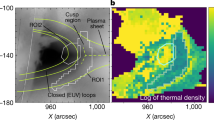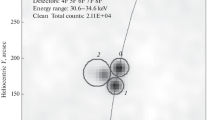Abstract
We analyze particle acceleration processes in large solar flares, using observations of the August, 1972, series of large events. The energetic particle populations are estimated from the hard X-ray and γ-ray emission, and from direct interplanetary particle observations. The collisional energy losses of these particles are computed as a function of height, assuming that the particles are accelerated high in the solar atmosphere and then precipitate down into denser layers. We compare the computed energy input with the flare energy output in radiation, heating, and mass ejection, and find for large proton event flares that:
-
(1)
The ∼10–102 keV electrons accelerated during the flash phase constitute the bulk of the total flare energy.
-
(2)
The flare can be divided into two regions depending on whether the electron energy input goes into radiation or explosive heating. The computed energy input to the radiative quasi-equilibrium region agrees with the observed flare energy output in optical, UV, and EUV radiation.
-
(3)
The electron energy input to the explosive heating region can produce evaporation of the upper chromosphere needed to form the soft X-ray flare plasma.
-
(4)
Very intense energetic electron fluxes can provide the energy and mass for interplanetary shock wave by heating the atmospheric gas to energies sufficient to escape the solar gravitational and magnetic fields. The threshold for shock formation appears to be ∼1031 ergs total energy in >20 keV electrons, and all of the shock energy can be supplied by electrons if their spectrum extends down to 5–10 keV.
-
(5)
High energy protons are accelerated later than the 10–102 keV electrons and most of them escape to the interplanetary medium. The energetic protons are not a significant contributor to the energization of flare phenomena. The observations are consistent with shock-wave acceleration of the protons and other nuclei, and also of electrons to relativistic energies.
-
(6)
The flare white-light continuum emission is consistent with a model of free-bound transitions in a plasma with strong non-thermal ionization produced in the lower solar chromosphere by energetic electrons. The white-light continuum is inconsistent with models of photospheric heating by the energetic particles. A threshold energy of ∼5×1030 ergs in >20 keV electrons is required for detectable white-light emission.
The highly efficient electron energization required in these flares suggests that the flare mechanism consists of rapid dissipation of chromospheric and coronal field-aligned or sheet currents, due to the onset of current-driven Buneman anomalous resistivity. Large proton flares then result when the energy input from accelerated electrons is sufficient to form a shock wave.
Similar content being viewed by others
References
Arnoldy, R. L., Kane, S. R. and Winckler, J. R.: 1968a, Astrophys. J. 151, 711.
Arnoldy, R. L., Kane, S. R. and Winckler, J. R.: 1968b, University of Minnesota, Cosmic Ray Technical Report CR-108.
Bratenahl, A. and Baum, P. J.: 1976, Solar Phys. 47, 345.
Brown, J. C.: 1971, Solar Phys. 18, 489.
Brown, J. C.: 1973a, Solar Phys. 29, 421.
Brown, J. C.: 1973b, Solar Phys., 31, 143.
Brown, J. C. and Hoyng, P.: 1975, Astrophys. J. 200, 734.
Buneman, O.: 1959, Phys. Rev. 115, 503.
Canfield, R. C.: 1974, Solar Phys. 34, 339.
Chupp, E. L., Forrest, D. J. and Suri, A. N.: 1973, in R. Ramaty and R. G. Stone (eds.), High Energy Phenomena on the Sun, NASA SP-342, p. 285.
Colgate, S. A.: 1965, J. Geophys. Res. 70, 3161.
Datlow, D. W.: 1975, in S. R. Kane (ed.), ‘Solar, Gamma-, X-, and EUV Radiation’, IAU Symp. 68, 191.
Dere, K. P., Horan, D. M. and Kreplin, R. W.: 1973, Collected Data Reports on August 1972 Solar Terrestrial Events, World Data Center A, UAG-78, part II, p. 298.
Donnelly, R. F. and Hall, L. A.: 1973, Solar Phys. 31, 411.
Donnelly, R. F., Wood, Jr., A. T. and Noyes, R. W.: 1973, Solar Phys. 29, 107.
Dryer, M.: 1974, Space Sci. Rev. 15, 403.
Dryer, M., Smith, Z. K., Steinoltson, R. S., Mihalov, J. D., Wolfe, J. H. and Chao, J. K.: 1976, J. Geophys. Res., 81, 4651.
Elliott, H.: 1964, Planetary Space Sci. 12, 657.
Ellison, M. A.: 1963, Planetary Space Sci. 11, 597.
Frost, K. J.: 1974, paper presented at Solar Physics-Plasma Physics Workshop held at Stanford University, Sept. 17–20.
Frost, K. J. and Dennis, B. K.: 1971, Astrophys. J. 165, 655.
Gingerich, O., Noyes, R. W., Kalkofen, W. and Cuny, Y.: 1971, Solar Phys. 18, 347.
Ginzburg, V. L. and Syrovatskii, S. I.: 1964, The Origin of Cosmic Rays. Pergamon Press, p. 97.
Gordon, I. M.: 1954, Doklady AN SSSR 94, 813.
Gosling, J. T., Hildner, E., MacQueen, R. M., Numro, R. H., Poland, A. I. and Ross, C. L.: 1974, J. Geophys. Res. 79, 4581.
Hamberger, S. M. and Friedman, M.: 1968, Phys. Rev. Lett. 21, 674.
Hamberger, S. M., Jancarik, J., Sharp, L. E., Aldcroft, D. A. and Wetherall, A.: 1971, Proceedings International Conference Plasma Physics and Controlled Nuclear Fusion, Vol. II, p. 37.
Hoyng, P.: 1975, Doctoral thesis, University of Utrecht, The Netherlands.
Hudson, H. S.: 1972, Solar Phys. 24, 414.
Hudson, H. S.: 1973, in R. Ramaty and R. G. Stone (eds.), High Energy Phenomena on the Sun, NASA, SP-342, p. 207.
Hundhausen, A. J. and Gentry, R. A.: 1969, J. Geophys. Res. 74, 2900.
Jackson, J. D.: 1962, Classical Electrodynamics, J. Wiley and Sons, N.Y.
Jefferies, J. T. and Orrall, F. Q.: 1961, Astrophys. J. 133, 946.
Kahler, S. W. and Kreplin, R. W.: 1971, Astrophys. J. 168, 531.
Kane, S. R.: 1974, in Gordon Newkirk Jr. (ed.), ‘Coronal Disturbances’, IAU Symp. 57, 105.
Kane, S. R. and Winckler, J. R.: 1969, University of Minnesota Cosmic Ray Technical Report, CR-135.
Lin, R. P.: 1973, in R. Ramaty and R. G. Stone (eds.), High Energy Phenomena on the Sun, NASA SP-342, p. 439.
Lin, R. P. and Hudson, H. S.: 1971, Solar Phys. 17, 412.
Machado, M. and Rust, D. M.: 1974, Solar Phys. 38, 499.
McDaniel, E. W.: 1964, Collision Phenomena in Ionized Gases, J. Wiley and Sons, p. 600.
McGuire, R. E.: 1976, Ph.D. Thesis, Physics Department, University of California, Berkeley.
McIntosh, P. S. and Donnelly, R. F.: 1972, Solar Phys. 23, 444.
Najita, K. and Orrall, F. Q.: 1970, Solar Phys. 15, 176.
Nakagawa, Y. and Raadu, M. A.: 1972, Solar Phys. 25, 127.
Neupert, W. M., Thomas, R. J. and Chapman, R. D.: 1974, Solar Phys. 34, 349.
Peterson, L. D., Datlowe, D. W. and McKenzie, D. L.: 1973, in R. Ramaty and R. G. Stone (eds.), High Energy Phenomena on the Sun, NASA, SP-342, p. 132.
Ramaty, R., Kozlovsky, B. and Lingenfelter, R. E.: 1975, Space Sci. Rev. 18, 341.
Ramaty, R. and Lingenfelter, R. E.: 1975, in S. R. Kane (ed.), ‘Solar Gamma, X-, and EUV Radiation’, IAU Symp. 68, 363.
Ramaty, R. and Wang, H. T.: 1975, 14th International Cosmic Ray Conference Proceedings, 5, 1635.
Reinhard, R. and Wibbernez, G.: 1974, Solar Phys. 36, 473.
Roelof, E. C., Lezniak, J. A., Webber, W R., McDonald, F. B., Teegarden, B. J. and Trainor, J. H.: 1974, in D. E. Page (ed.), Correlated Interplanetary and Magnetospheric Observations, D. Reidel, Publ., p. 563.
Rust, D. M. and Hegwer, F.: 1975, Solar Phys. 40, 141.
Severny, A. B.: 1957, Izv. Krymsk. Astrofiz. Observ. 17, 129.
Somov, B. V.: 1975, Solar Phys. 42, 235.
Stein, W. A. and Ney, E. P.: 1963, J. Geophys. Res. 68, 65.
Švestka, Z.: 1966, Space Sci. Rev. 5, 388.
Švestka, Z.: 1970, Solar Phys. 13, 471.
Sweet, P. A.: 1969, Annual Review Astron. Astrophys. 8, 149.
Tanaka, K. and Nakagawa: 1973, Solar Phys. 33, 187.
Thomas, R. N. and Athay, R. G.: 1961, Physics of the Solar Chromosphere, Interscience Publishers.
Trubnikov, B. A.: 1965, Rev. Plasma Phys. 1, 105.
Van Hollenbeke, M. A. I., MaSung, L. S. and McDonald, F. B.: 1975, Solar Phys. 41, 189.
Wang, H. T. and Ramaty, R.: 1974, Solar Phys. 36, 129.
Zirin, H. and Tanaka, K.: 1973, Solar Phys. 32, 173.
Author information
Authors and Affiliations
Rights and permissions
About this article
Cite this article
Lin, R.P., Hudson, H.S. Non-thermal processes in large solar flares. Sol Phys 50, 153–178 (1976). https://doi.org/10.1007/BF00206199
Received:
Revised:
Issue Date:
DOI: https://doi.org/10.1007/BF00206199




